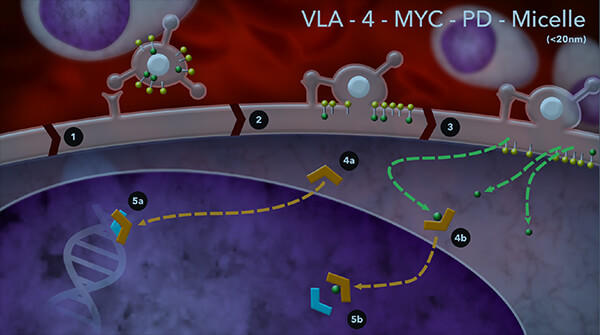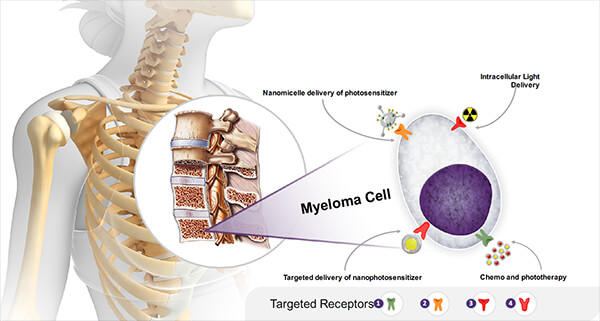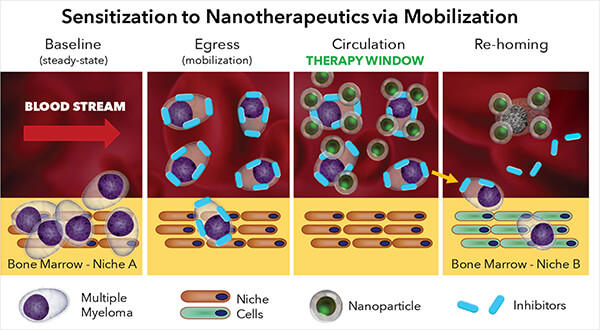Washington University — Center for Multiple Myeloma Nanotherapy (CNMN)
Center Overview
The Washington University Center for Multiple Myeloma Nanotherapy (WU CMMN) will address overarching questions in bone malignancies, with a focus on multiple myeloma (MM). MM is a hematopoietic disease caused by terminally differentiated malignant plasma B-cells. Despite tremendous improvements in MM patient management, nearly all patients will eventually relapse and die from it. Leveraging the enormous institutional resources and support, diverse expertise in MM, the integral participation of patient advocates and industry partners, and synergistic integration of basic and clinical investigators, the WU CMMN will serve as a comprehensive center for the development of nanotechnology-based solutions for treating MM and bone metastasis. Anchored by three projects and two cores, we aim to improve MM treatment outcomes with minimal off-target toxicity by developing novel nanotherapeutics that combine unique drug delivery mechanisms with spatiotemporal treatment paradigms.
Samuel Achilefu and Gregory Lanza are the PIs/PDs of the Center. Dr. Achilefu is a pioneer in the development of molecular imaging probes and nanomaterials for imaging and treatment of cancer. He currently leads the translation of innovative imaging technologies and molecular probes from bench to bedside. Dr. Lanza is a distinguished leader in the development and translation of nanomaterials to the clinic. He has extensive experience in the practice of medicine, nanomedicine research and development, and pharmaceutical development in large industry as well as small biotechnology start-ups. Three synergistic and highly interactive interdisciplinary research projects will anchor the center. Each project is led by senior investigators with expertise in basic and translational research.
Projects
Project 1: Preclinical and Clinical Imaging and Treatment of Multiple Myeloma with CMYC-MAX Nanoparticles
Project Investigators: Gregory Lanza, M.D., Ph.D., and Michael Tomasson, M.D.
Project 1 is led by Dr. Lanza and Michael Tomasson, a board-certified hematologist and highly acclaimed expert in both basic and clinical MM research. The team will use smartly designed VLA-4 targeted nanocolloids to selectively deliver novel cMyc-inhibitor prodrugs directly into MM cells to maximize therapy. Through its multiple levels of innovation, Project 1 will revitalize the therapeutic quest to target cMyc for translational development with targeted nanotherapy by synthetically modifying next generation Myc-Max small molecule antagonists.
Project 2: Spatiotemporally Controlled Light Therapy of Multiple Myeloma
Project Investigators: Samuel Achilefu, Ph.D., Katherine Weilbaecher, M.D., and Pratim Biswas, Ph.D.
Project 2 will utilize a novel spatiotemporal phototherapy to eradicate MM. The team will develop new photosensitizers that will generate diverse cytotoxic free radicals upon absorption of light from radionuclides inside MM cells. Through the ensuing multidimensional assault, the approach will selectively destroy MM cells with minimal systemic toxicity. Dr. Achilefu will lead this Project, accompanied by Katherine Weilbaecher, M.D., a world-class investigator and oncologist whose research interests are focused on understanding the molecular mechanisms of bone cancer and metastasis, and Pratim Biswas, Ph.D., an internationally recognized expert in high precision, metal-based nanomaterials synthesis.
Project 3: Combination Therapy to Improve the Efficacy of Multiple Myeloma-Targeted Nanotherapeutics
Project Investigator: John DiPersio, M.D., Ph.D., and William Frazier, Ph.D
Project 3 is discovery-focused and led by John DiPersio, a preeminent authority in the treatment of refractory and relapsed hematological malignancies and hematopoietic stem cell transplantation, and William Frazier, Ph.D, a pioneer in the field of thrombospondins and the discoverer of CD47, which is used in modulating bone marrow niche. The team will use innovative approaches for combination therapy with the bone marrow niche disrupting agents to enhance the efficacy of MM killing by the nanotherapeutics developed in Projects 1 and 2. The project will also elucidate the molecular mechanisms of nano-induced MM cell death.
Cores
Imaging Biomarker Quanification and Standardization (IBQS)
Core Investigator: Kooresh Shoghi, Ph.D.
The IBQS Core will develop quantitative benchmarks for assessing response to therapy in preclinical models of MM, thereby facilitating the clinical translation of the nanotherapeutics developed in Projects 1-3. This Core is led by Kooresh Shoghi, an expert in quantitative imaging technology with an established track record in correlating image biomarkers of disease with tissue biomarkers.
Data Management
Core Investigator: Fred Prior, Ph.D.
The Data Management Core will develop data acquisition and integration processes and procedures for each project, and interface local data with the NCI's caNanoLab. This Core is led by Fred Prior, an expert and leader in creating petabyte scale information repositories and in developing advanced techniques to mine new knowledge from these resources. He is also the PI of the Cancer Imaging Archive (TCIA) program.
Developmental Program
Center Program Director: Samuel Achilefu, Ph.D.
CMMN Developmental Program will support pilot and auxiliary projects that will augment the use of nanotechnology to improve the quality of life for MM and other cancer patients. This Program will encourage new and innovative approaches to increase the clinical impact of nanotechnology in oncology by linking physicians, biologists, physical scientists, engineers, bioinformatics, and technologists for the purpose of improving diagnosis, prevention, and treatment of cancer.


